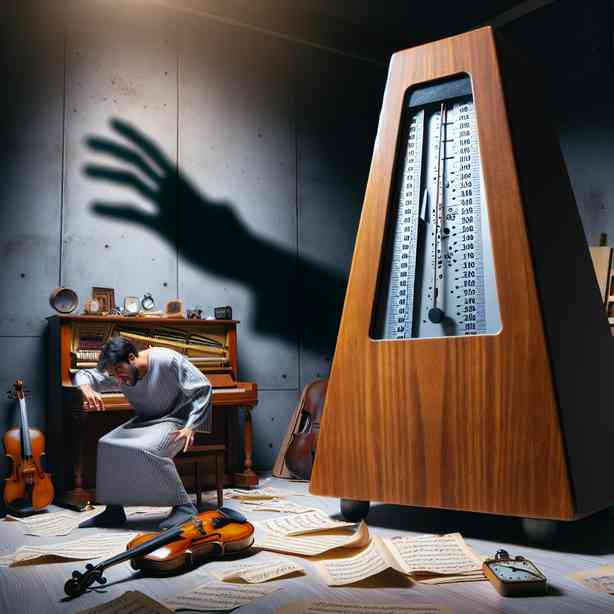
The metronome, a device designed to keep rhythm and maintain a steady beat, serves as a crucial tool for musicians. It offers countless benefits, particularly in the realms of timing, practice routines, and overall musical precision. However, there are occasions when the very aid meant to enhance musical performance can become a source of frustration and anxiety, ultimately acting as an adversary to an artist’s creativity.
When a musician first encounters a metronome, it often comes as a welcome introduction. The steady click, beep, or tick becomes a comforting companion during practice sessions, providing a clear framework for developing timing skills. Musicians learn to synchronize their playing with the metronome’s consistent pulse, which initially feels empowering. The regular beats help in mastering complex rhythms and facilitate the gradual increase of tempo as confidence builds.
However, as one delves deeper into the world of metronomes, a shift can occur. The very precision that once felt liberating can morph into a constricting force. As musicians focus intensely on adhering to the metronome’s timing, they may become overly reliant on it, leading to a rigid approach to playing. This rigidity can stifle creativity and self-expression, hallmark traits that make music a deeply personal form of art.
Over time, musicians might find themselves feeling anxious during rehearsals or performances, fearing that they will lose the beat or fail to meet the expectations set by the metronome. This anxiety can lead to a detrimental cycle; the more one practices with the metronome, the more it can feel like an enemy undermining the individual’s unique musical voice.
It is not uncommon for musicians to find themselves trapped in this cycle, where the desire for perfect timing overshadows the enjoyment of making music. This is where the phenomenon of the metronome becoming the enemy truly manifests. Musicians may start to feel that their creativity is being squashed under the weight of an unforgiving, mechanical rhythm. Such feelings can inhibit a player’s natural spontaneity and emotional connection to the music they create.
To counteract this dilemma, it is essential for musicians to strike a balance in their practice routines. While it is important to embrace the metronome for its beneficial qualities, it is equally vital to remember the essence of music: expressiveness, emotional depth, and personal interpretation. Musicians can incorporate the metronome in ways that allow for flexibility rather than rigidity. For instance, using it sporadically during practice can help maintain timing without compromising artistic freedom.
Additionally, musicians can experiment with different tempos, or even use the metronome in a varied manner, playing around with accents and rhythmic variations to make the practice feel more dynamic and less mechanical. This approach can help musicians develop their own internal sense of timing, reducing the dependency on the metronome while still harnessing its advantages.
Moreover, embracing improvisation is another powerful strategy for combating feelings of restriction imposed by the metronome. Musicians can dedicate specific practice sessions for free playing or improvisation, allowing the music to flow without the confines of strict timing. This practice can remind them of the joy of music-making, awakening creativity that may have been dulled by a rigid adherence to metronomic timing.
Moreover, it’s prudent to recognize the importance of emotional intelligence in music. Understanding that music is not solely about technical perfection but also about conveying feelings can help shift the perspective of the metronome from being an enemy to a helpful, albeit sometimes necessary companion. Engaging in reflective practices, like journaling about musical experiences, can help musicians reconnect with their artistic intentions and values, reinforcing the notion that the journey of making music is just as essential as the outcome.
As we explore these varied approaches, it’s clear that the relationship between musicians and the metronome can be nuanced and complex. What began as a tool for accountability can easily morph into a source of detriment if not used mindfully. Musicians must foster an environment where self-acceptance and creativity can flourish alongside precision, ensuring that the metronome serves its purpose without overshadowing the artist’s innate expression.
Ultimately, adopting a holistic approach to music practice can prevent the metronome from becoming an antagonist in the creative process. By recognizing its limitations and potential pitfalls, musicians can harness its strengths for growth while maintaining a strong sense of personal expression. The journey through music is one of discovery, and this relationship with the metronome should be one of collaboration rather than conflict.
In conclusion, as musicians navigate their growth and artistry, they must remain vigilant against the metronome’s dual nature. By staying attuned to their emotional responses during practice and performance, artists can ensure that their creativity remains at the forefront, allowing music to be a fulfilling expression rather than a source of tension. The metronome can indeed be a valuable ally, provided that it is approached with a balanced mindset. With these insights in mind, musicians can thrive, creating beautifully expressive art that resonates with their audience while honoring their unique voice.


